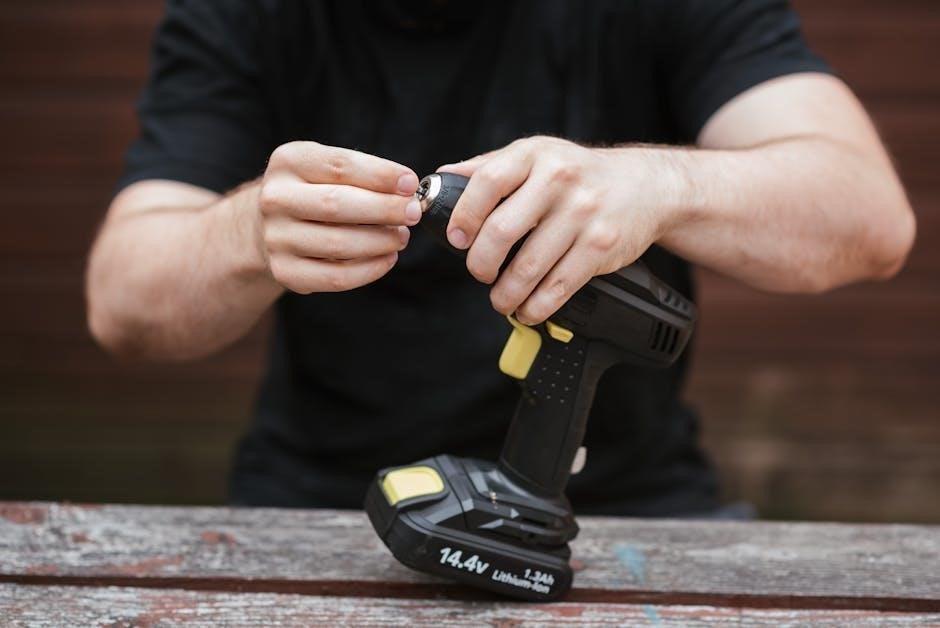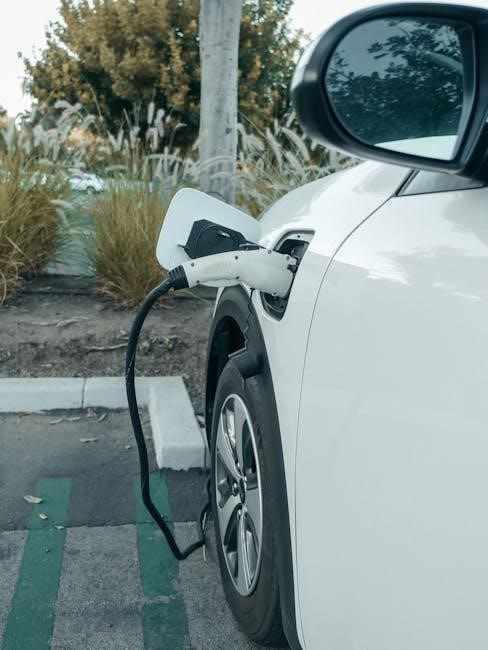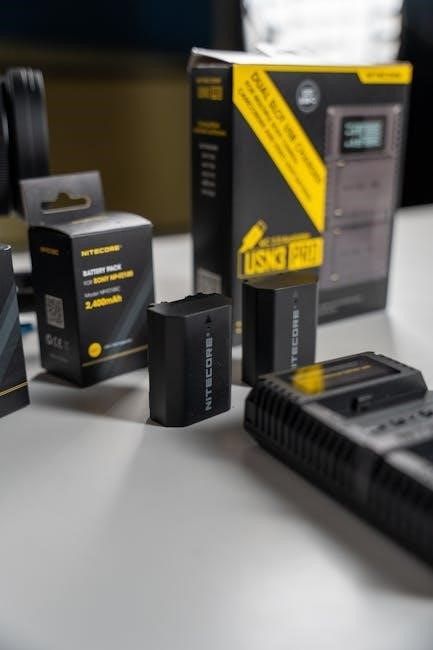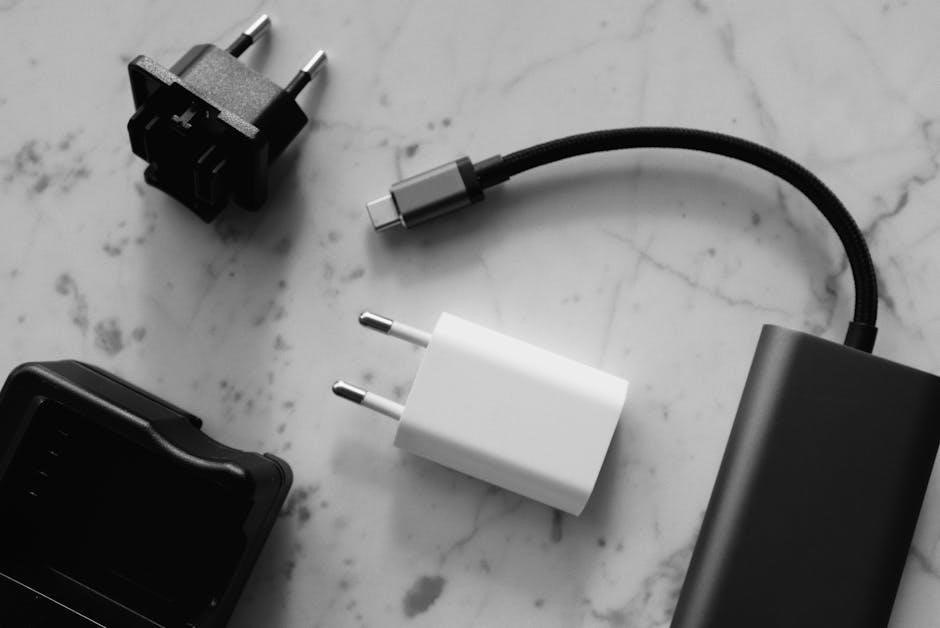EverStart Battery Charger Manual: A Comprehensive Guide
Unlock the full potential of your EverStart battery charger with our comprehensive guide․ Whether you have the BC50BE or another model, this resource provides essential information․ Learn how to safely operate, troubleshoot common issues, and maintain your charger for optimal performance and longevity․
EverStart battery chargers are designed to revive and maintain the health of your vehicle’s battery․ These chargers come in various models, each tailored for different battery types and charging needs․ From basic trickle chargers to advanced smart chargers with multiple modes, EverStart offers solutions for automotive, marine, and other applications․ Understanding the capabilities and features of your specific EverStart model is crucial for safe and effective use․
These chargers are equipped with features like automatic shut-off, reverse polarity protection, and LCD displays to monitor charging progress․ Manuals for EverStart chargers like the MAXX BC50BE provide detailed instructions on setup, operation, and troubleshooting․
It’s important to refer to the user manual before operating any EverStart charger․ The manual contains key safety precautions, step-by-step charging instructions, and information on interpreting indicator lights․ This guide aims to provide an overview of EverStart battery chargers, emphasizing the importance of consulting your model’s specific manual for optimal use and battery maintenance․ Properly using your EverStart charger can extend battery life and ensure reliable performance․
Understanding Your EverStart Model Number
The model number on your EverStart battery charger is more than just a random string of characters; it’s a key to understanding the charger’s capabilities and features․ Deciphering this code can help you determine the charger’s amperage, voltage compatibility, and specific functionalities․ For instance, the EverStart Maxx BC50BE indicates a 15 Amp automatic battery charger with engine start capabilities․
Typically, the model number will include letters and numbers that represent the charger’s series (e․g․, BC for Battery Charger), maximum charging amperage (e․g․, 50 for 15 amp), and any special features or design revisions (e․g․, BE)․ Referring to your user manual is essential to fully decode your specific model number․ Different models, like the BC4WE or BC40BE, have unique characteristics that are outlined in their respective manuals․
Understanding your model number allows you to quickly identify the correct user manual, find compatible accessories, and troubleshoot issues more effectively․ Always cross-reference the model number on your charger with the one listed in the manual to ensure you have the right information․ Knowing your model helps you maximize your charger’s potential․
Key Features of EverStart Battery Chargers
EverStart battery chargers come equipped with a range of features designed to make battery maintenance easier and more efficient․ Many models, such as the EverStart Maxx BC50BE, offer automatic charging capabilities, adjusting the charging rate based on the battery’s needs․ This prevents overcharging and helps extend the battery’s life․ Some chargers also include a maintainer function, ideal for storing batteries long-term․
Another common feature is multi-stage charging, which optimizes the charging process for different battery types, including AGM, GEL, and WET batteries․ Indicator lights provide real-time feedback on the charging status, and some models feature LCD screens for detailed information․ Safety features like reverse polarity protection and short circuit protection are standard, ensuring safe operation;
Select EverStart chargers also offer engine start assistance, delivering a high amperage boost to help start vehicles with weak batteries․ USB charging ports are included on some models, allowing you to charge mobile devices․ These features, combined with user-friendly interfaces, make EverStart battery chargers versatile tools for any vehicle owner․ Always consult the user manual to fully understand the features specific to your model․
Safety Precautions Before Use
Before using any EverStart battery charger, it is imperative to prioritize safety to prevent personal injury or damage to the equipment․ Always read the complete instruction manual and your vehicle’s user manual before operating the charger․ Ensure that you are working in a well-ventilated area, as charging batteries can produce explosive gases․ Wear safety glasses and appropriate protective gear to shield your eyes and skin from battery acid․
Verify that the charger’s voltage settings match the voltage of the battery you intend to charge․ Incorrect voltage settings can lead to battery damage or hazardous conditions․ Inspect the charger’s cables and clamps for any signs of damage, such as frayed wires or cracked insulation․ Never use a charger with damaged components․
When connecting the charger to the battery, ensure proper polarity․ Connect the positive (red) clamp to the positive terminal and the negative (black) clamp to the negative terminal․ If the battery is installed in a vehicle, refer to the vehicle’s manual for specific instructions and grounding procedures․ Keep sparks, flames, and lit cigarettes away from the battery during charging, and never attempt to charge a frozen battery․ Following these precautions will ensure safe and effective use of your EverStart battery charger․
Charging the Battery: Step-by-Step Instructions
To effectively charge a battery using an EverStart charger, begin by ensuring the area is well-ventilated and free from flammable materials․ Put on safety glasses and gloves․ Disconnect the battery from the vehicle if recommended by the vehicle’s manufacturer․ Clean the battery terminals with a wire brush to remove any corrosion, ensuring a good connection․
Connect the red (positive) clamp of the charger to the positive terminal of the battery․ Then, connect the black (negative) clamp to the negative terminal or a suitable grounding point on the vehicle’s chassis, away from the battery and fuel lines, if the battery remains in the vehicle․
Select the appropriate charging mode on the EverStart charger based on the battery type (e․g․, AGM, GEL, or standard lead-acid) and desired charging rate․ Refer to the charger’s manual for guidance on selecting the correct settings․ Once the settings are selected, plug the charger into a grounded AC outlet․ Monitor the charger’s indicator lights to track the charging progress․ Once the battery is fully charged, indicated by the charger, disconnect the charger from the AC outlet before disconnecting the clamps from the battery terminals, reversing the connection sequence․ Always consult your EverStart charger’s manual for specific instructions․
Using the Charger’s Different Modes
EverStart battery chargers often come equipped with multiple modes to cater to various charging needs and battery types․ Understanding these modes is crucial for effective and safe battery charging․ A common mode is the “Automatic” or “Smart” mode, where the charger automatically adjusts the charging rate based on the battery’s condition and charge level․ This mode is suitable for most standard charging scenarios, preventing overcharging and maintaining optimal battery health․
Some chargers also offer a “Manual” mode, allowing you to manually set the charging voltage and current․ This mode is typically used by experienced users who need precise control over the charging process․ Another useful mode is the “Engine Start” or “Boost” mode, which provides a high current boost to help start a vehicle with a weak battery․ However, this mode should be used sparingly and according to the manufacturer’s instructions to avoid damaging the battery or the vehicle’s electrical system․
Additionally, some EverStart chargers feature a “Maintenance” or “Float” mode, designed to keep a battery fully charged over extended periods without overcharging․ This mode is ideal for batteries in storage or vehicles that are not frequently used․ Always refer to your EverStart charger’s manual for detailed explanations of each mode and their appropriate applications․
Interpreting the Charger’s Indicator Lights
EverStart battery chargers use indicator lights to communicate the charging status and any potential issues․ Understanding these lights is essential for monitoring the charging process and ensuring safe operation․ Typically, a green light indicates that the battery is fully charged or in maintenance mode․ A red light often signifies an error, such as reverse polarity, a faulty battery, or an overcharge situation․
A flashing green or yellow light may indicate that the charger is in the process of charging, with the flashing rate varying depending on the charge level․ Some chargers also have separate lights for different charging modes, such as a “Boost” light for engine starting or an “AGM” light for charging AGM batteries․ Pay close attention to the color and pattern of the lights, as they provide valuable information about the charger’s operation․

If you encounter an error light, consult your EverStart charger’s manual for troubleshooting steps․ Common issues include incorrect connections, incompatible battery types, or internal charger faults․ Ignoring error lights can lead to battery damage or unsafe conditions․ The indicator lights are your primary source of feedback from the charger, so understanding their meaning is crucial for effective and safe battery maintenance․ Always refer to the user manual for a complete guide․
Troubleshooting Common Issues

Encountering issues with your EverStart battery charger can be frustrating, but many problems can be resolved with simple troubleshooting steps․ One common issue is the charger failing to recognize the battery; Ensure the battery connections are clean and secure, and that the clamps are properly attached to the correct terminals․ Reverse polarity, where the positive and negative clamps are reversed, is a frequent cause of this problem; the red light may illuminate․
If the charger indicates a fault, such as an overcharge or a short circuit, disconnect the charger immediately and inspect the battery for damage․ A bulging or cracked battery indicates a serious issue and should be handled with care․ Another common problem is the charger taking an excessively long time to charge the battery․ This may indicate a sulfated battery, which requires a desulfation mode if your charger has one, or a battery that’s beyond its useful life․
If the charger’s fan isn’t running or it’s overheating, check for any obstructions and ensure proper ventilation․ If these steps don’t resolve the problem, consult the user manual for more specific troubleshooting guidance or contact EverStart customer support․ Remember to always prioritize safety when working with electrical devices and batteries․ If unsure, seek professional assistance․
Maintenance and Storage Tips

Proper maintenance and storage are crucial for extending the lifespan of your EverStart battery charger․ After each use, disconnect the charger from both the battery and the power outlet․ Clean the clamps with a wire brush to remove any corrosion or debris, ensuring good contact for future charging sessions․ Wipe down the charger’s exterior with a dry cloth to remove dust and grime․
When storing your EverStart battery charger, choose a cool, dry, and clean environment․ Avoid areas with high humidity or extreme temperatures, as these can damage the internal components․ Store the charger in its original packaging or a protective case to prevent dust and physical damage․ Ensure the power cord is neatly coiled to prevent tangling or damage․
Periodically inspect the power cord and clamps for any signs of wear or damage․ If you notice frayed wires, cracked insulation, or damaged clamps, replace them immediately to avoid electrical hazards․ Before long-term storage, consider applying a small amount of dielectric grease to the clamps to prevent corrosion․ By following these maintenance and storage tips, you can ensure your EverStart battery charger remains in optimal condition and ready for reliable use whenever you need it․
Where to Find the User Manual
Locating the user manual for your EverStart battery charger is essential for safe and effective operation․ If you’ve misplaced the physical copy that came with your charger, don’t worry, there are several ways to access it․ Start by checking the packaging the charger came in, as the manual might be stored there․ Next, visit the official website, often you can find a digital version of the manual in PDF format․
Alternatively, try searching online using the model number of your EverStart charger, such as BC50BE or BC40BE, along with the terms “user manual” or “instruction manual․” Websites like ManualsLib often host a variety of user manuals for different EverStart models, allowing you to view or download them for free․ You can also check the retailer’s website where you purchased the charger, as they may provide a link to the manual on the product page․
If you’re still unable to find the manual, consider contacting EverStart’s customer support directly․ They should be able to provide you with a digital copy or guide you to the appropriate resource․ Having access to the user manual ensures you can properly understand the features, safety precautions, and operating instructions of your EverStart battery charger, maximizing its performance and longevity․

Understanding Battery Codes and Compatibility
Ensuring your EverStart battery charger is compatible with your battery type is crucial for safe and efficient charging․ Battery codes, typically heat-stamped on the battery case or cover, provide vital information about the battery’s specifications․ These codes indicate the battery’s group size, voltage, cold cranking amps (CCA), and other essential characteristics․ Consulting your vehicle’s user manual will help determine the appropriate battery group size for your car․
Before charging, verify that the voltage of your battery matches the voltage settings on your EverStart charger․ Most automotive batteries are 12V, but some may be 6V․ Using the incorrect voltage setting can damage the battery or the charger․ Also, consider the battery type, such as AGM, GEL, or flooded lead-acid, and select the corresponding mode on your charger if available․
Refer to the EverStart charger’s user manual for a compatibility chart or guidelines on selecting the correct charging mode for your battery type․ If you’re unsure about the battery code or compatibility, consult a professional mechanic or battery specialist․ Incorrectly charging a battery can lead to reduced performance, shortened lifespan, or even hazardous situations․ Always prioritize safety and compatibility when using your EverStart battery charger․

Leave a Reply